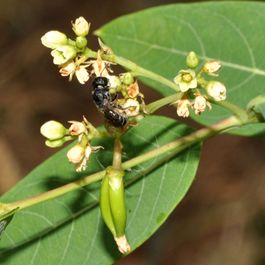Pollen transfer efficiency of Apocynum cannabinum (Apocynaceae): a comparative perspective
DOI:
https://doi.org/10.26786/1920-7603(2018)fourAbstract
Pollen transfer efficiency (PTE), the percentage of removed pollen delivered to conspecific stigmas, has been implicated in the morphological evolution, population dynamics, and lineage diversification of flowering plants. Pollinia, the aggregated contents of pollen sacs, present in Apocynaceae subfamilies Asclepiadoideae (milkweeds), Secamonoideae, and Periplocoideae and orchids (Orchidaceae), are the pre-eminent example of a plant trait that elevates PTE (to ca. 25%). However comparison of species with pollinia to “average” flowers (PTE ca. 1%) may over-estimate the gains from pollinia. We hypothesize that elevated PTE evolved in Apocynaceae prior to pollinia. We measured PTE and pollen to ovule ratio, a possible correlate of PTE, in Apocynum cannabinum, a milkweed relative with pollen tetrads (instead of pollinia) and simple bands of style head adhesive (instead of complex pollinium-carrying translators), comparing them to reports of other species collated from the literature. PTE of A. cannabinum is 7.9%, in the 24th percentile of reports for 35 milkweed species, but more than twice the highest PTE reported for a species with monads (3.4%). The bands of style head adhesive are functionally equivalent to the translators of milkweeds. The pollen to ovule ratio of A. cannabinum, at 19.8, is in the 94th percentile of ratios reported for milkweeds (mean 9.6). Our results are consistent with the hypothesis that floral novelties of Apocynaceae that evolved prior to pollinia also promote aggregated pollen transport and elevated PTE.

Downloads
Additional Files
Published
How to Cite
Issue
Section
License
Copyright (c) 2018 Tatyana Livshultz, Sonja Hochleitner, Elizabeth Lakata

This work is licensed under a Creative Commons Attribution 4.0 International License.
JPE is an open access journal which means that all content is freely available without charge to the user or his/her institution.
Authors who publish with this journal agree to the following terms:
1) Authors retain copyright and grant the journal right of first publication with the work simultaneously licensed under a Creative Commons Attribution License that allows others to share the work with an acknowledgement of the work's authorship and initial publication in this journal.
2) Authors are able to enter into separate, additional contractual arrangements for the non-exclusive distribution of the journal's published version of the work (e.g., post it to an institutional repository or publish it in a book), with an acknowledgement of its initial publication in this journal.
3) Authors are permitted and encouraged to post their work online (e.g., in institutional repositories or on their website) prior to and during the submission process, as it can lead to productive exchanges, as well as earlier and greater citation of published work (See The Effect of Open Access).
To assure a broader targeted audience, content will be included into databases (such as EBSCO) and directories (such as DOAJ).











